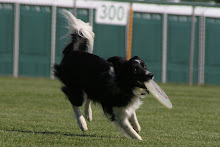Well that didn't take long. I got a new book. "Reaching the Animal Mind" by Karen Pryor. Mind-blowing. I want to get a fish, or a hamster, and clicker train it! But I don't have time for another pet, so I will have to settle for my dogs. ;-)
I am working with Elo on learning to let me clip his nails without having to hold him down. I figure, if they can teach elephants to present their feet calmly for maintenance, surely my little biddable cattle dog can do it! (If only his nails didn't grow so fast--the book doesn't say how they take care of these animals in the mean time before they are trained.) I started with straight counter-conditioning. Touch a foot; get a treat, hold a foot; get a treat. It was working, but slow going. A verbal marker helped speed things up a bit more and a clicker was even more effective! Criterion--let me touch your foot without pulling away.
Then I tried something from the book. The book described an experiment in which several dogs were asked to cross novel/scary obstacles (e.g., a pile of rope on the ground). Luring with food had the dogs going around the obstacles, shaping with a clicker and food reward produced faster results, but the fastest results came when the behavior of interacting with the obstacle was marked with a cue for the dog's favorite trick! So you were harnessing the value of not only a single food reinforcement, but also the value of a behavior that has a long history of paying off. I tried it with Elo, reinforcing for not pulling his foot away with a "touch" cue (nose target). After just a couple repetitions of this he immediately seemed more comfortable with the entire exercise and progress has been faster since then. And to keep "touch" from getting boring or predictable for him, I've been interspersing other cues as the reward, and occasionally rewarding only with food.
This concept of reinforcing a behavior with a cue is mind-boggling, and the idea that a cue with a long reinforcement history could be even more reinforcing than a "primary reinforcer" even more so. I'm not totally sure why it works or how it works. But I have now seen it for myself, so apparently it does work.
I don't really have any more solid plans for training than I did last week, but I sure have a lot of new ideas to think about!
Subscribe to:
Post Comments (Atom)





I love my copy of "Reaching the Animal Mind." It's signed by Karen Pryor. She clicked! me.
ReplyDeleteB and I did a lot of work with nails when I got her. She needed to be muzzled and held down before. Within just a few weeks, we were able to trim her nails without anything but a handful of treats. The trick was to do short, frequent sessions (just like with everything else). Sounds like you're on the right track!
I love that book!
ReplyDeleteI've always wanted to shape something with another behavior as the reinforcer but haven't done it yet :( It is just mind boggling how it can make progress faster!
I need to revisit nail trims with both my dogs. Both tolerate it, but Vito has gotten worse (as with everything it seems) and now just trembles when I merely touch his foot. He doesn't even like shake any more. Perhaps I will join you.
Poor Vito! Maybe this is your chance to shape something with a cue reinforcer. I still think it makes a difference using the cue AS the marker and not marking and then giving the cue, though I'm not sure why. I think that's how they did it in the book.
ReplyDelete